Household Waste Management: A Comprehensive Research Report
VerifiedAdded on 2022/09/16
|27
|6370
|17
Report
AI Summary
This report provides a comprehensive analysis of household waste management practices, focusing on the identification and management of hazardous waste. It explores the constituents of household waste and the factors influencing its composition, including economic development, geography, climate, and energy sources. The report discusses the dangers of improper disposal, including its effects on the environment and the health risks faced by sanitation workers. It highlights the importance of the 3Rs (reduce, reuse, recycle) and explores various disposal methods, such as incineration, landfilling, and energy recovery. The paper emphasizes the need for effective waste management strategies to protect public health and the environment, advocating for source reduction, proper handling, and the adoption of sustainable practices. The report also touches upon the role of government and industries in designing policies to educate the public and protect sanitation workers. It underscores the importance of proper waste disposal to prevent contamination of natural resources and the migration of hazardous chemicals into land, air, and water. The report concludes with a call for collaborative efforts to promote sustainable waste management and protect the environment for future generations.
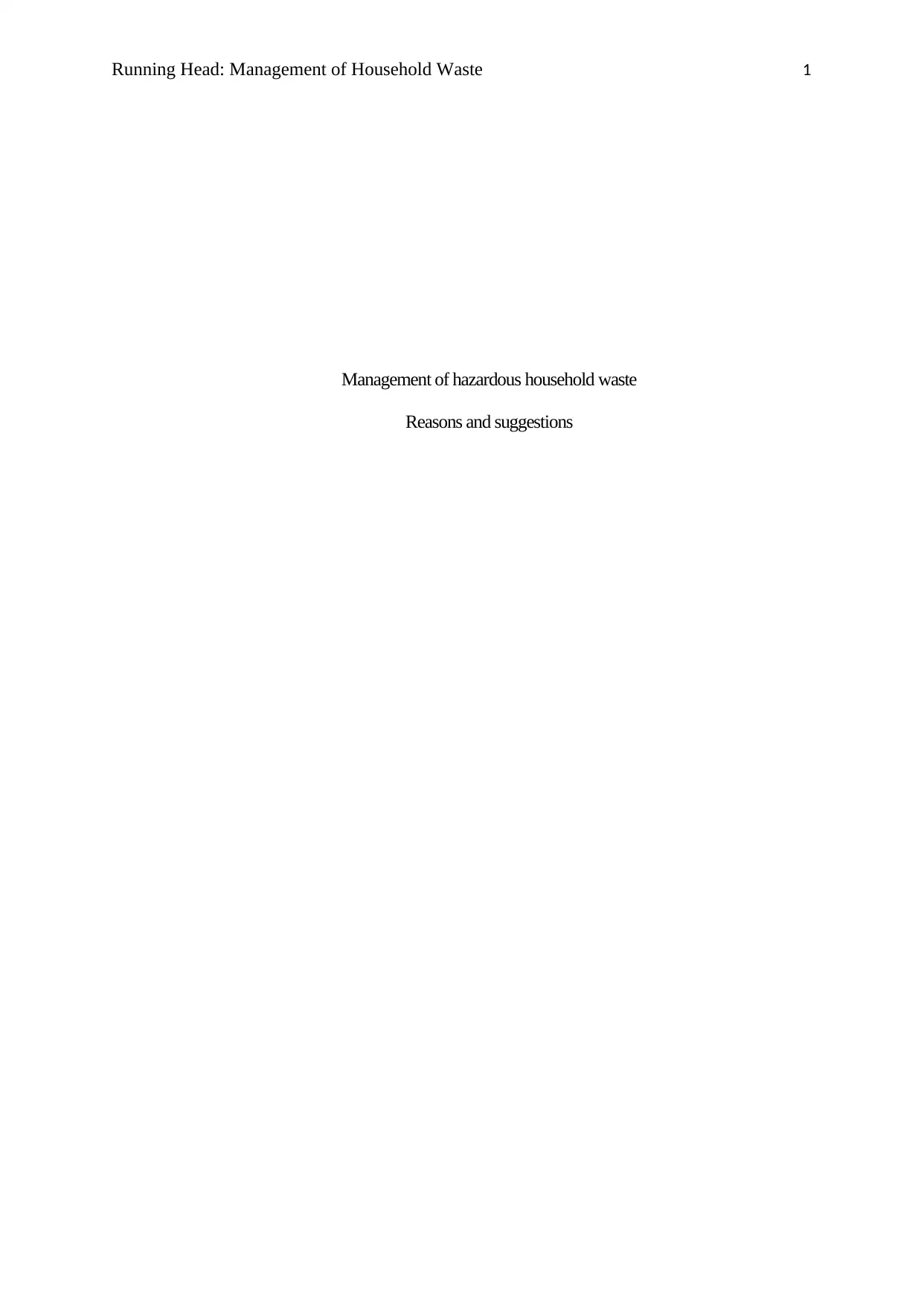
Running Head: Management of Household Waste 1
Management of hazardous household waste
Reasons and suggestions
Management of hazardous household waste
Reasons and suggestions
Paraphrase This Document
Need a fresh take? Get an instant paraphrase of this document with our AI Paraphraser
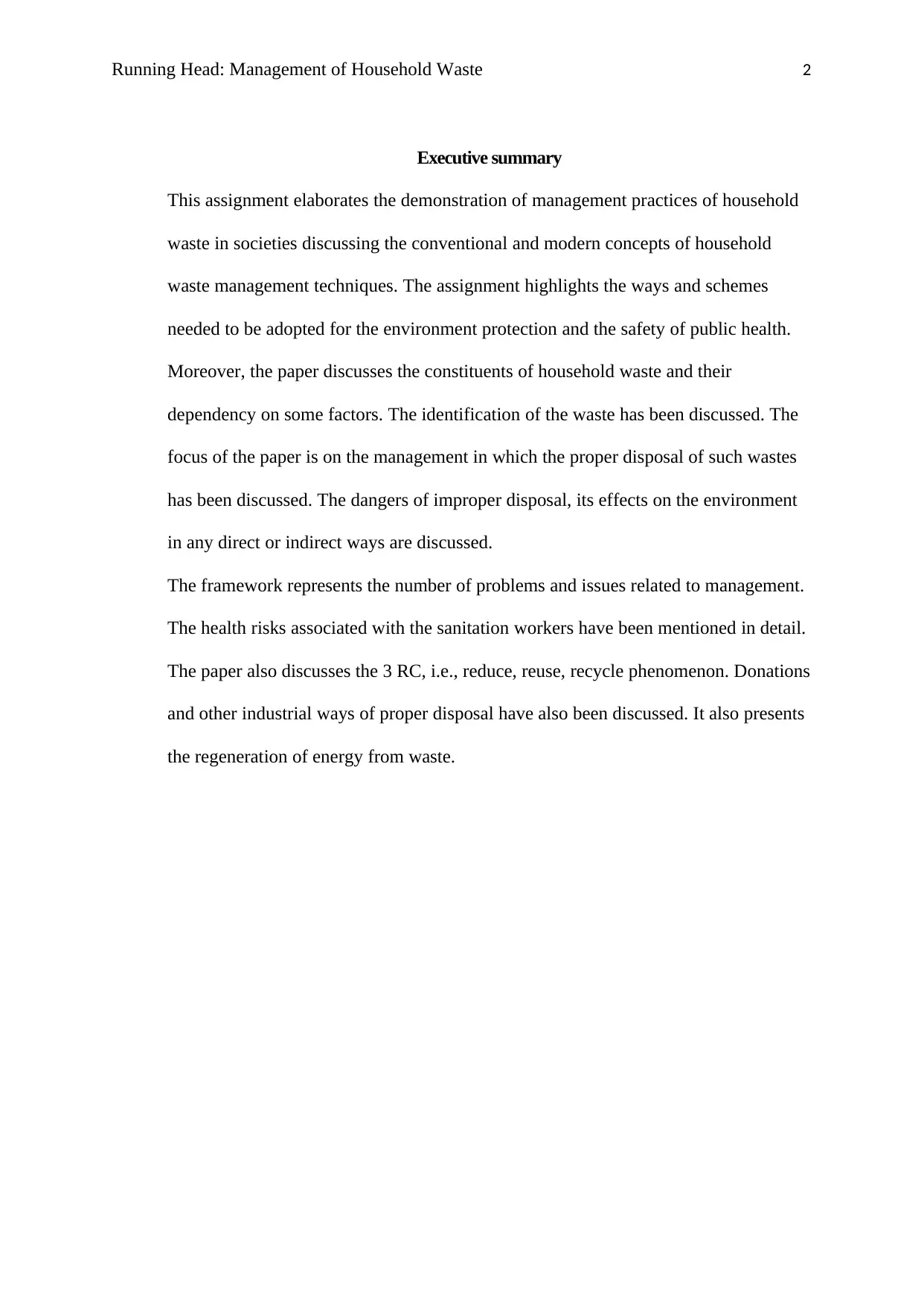
Running Head: Management of Household Waste 2
Executive summary
This assignment elaborates the demonstration of management practices of household
waste in societies discussing the conventional and modern concepts of household
waste management techniques. The assignment highlights the ways and schemes
needed to be adopted for the environment protection and the safety of public health.
Moreover, the paper discusses the constituents of household waste and their
dependency on some factors. The identification of the waste has been discussed. The
focus of the paper is on the management in which the proper disposal of such wastes
has been discussed. The dangers of improper disposal, its effects on the environment
in any direct or indirect ways are discussed.
The framework represents the number of problems and issues related to management.
The health risks associated with the sanitation workers have been mentioned in detail.
The paper also discusses the 3 RC, i.e., reduce, reuse, recycle phenomenon. Donations
and other industrial ways of proper disposal have also been discussed. It also presents
the regeneration of energy from waste.
Executive summary
This assignment elaborates the demonstration of management practices of household
waste in societies discussing the conventional and modern concepts of household
waste management techniques. The assignment highlights the ways and schemes
needed to be adopted for the environment protection and the safety of public health.
Moreover, the paper discusses the constituents of household waste and their
dependency on some factors. The identification of the waste has been discussed. The
focus of the paper is on the management in which the proper disposal of such wastes
has been discussed. The dangers of improper disposal, its effects on the environment
in any direct or indirect ways are discussed.
The framework represents the number of problems and issues related to management.
The health risks associated with the sanitation workers have been mentioned in detail.
The paper also discusses the 3 RC, i.e., reduce, reuse, recycle phenomenon. Donations
and other industrial ways of proper disposal have also been discussed. It also presents
the regeneration of energy from waste.
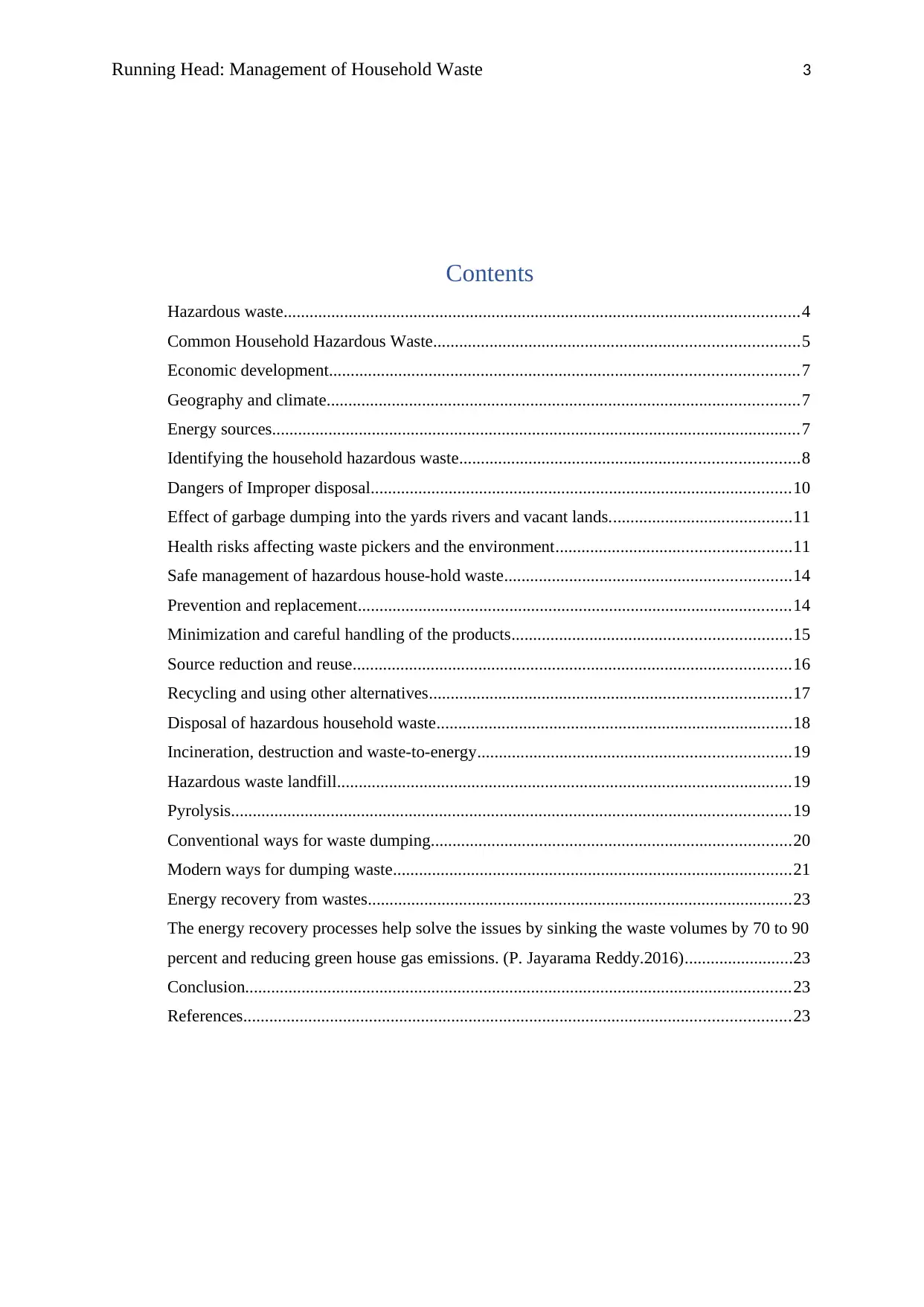
Running Head: Management of Household Waste 3
Contents
Hazardous waste.......................................................................................................................4
Common Household Hazardous Waste....................................................................................5
Economic development............................................................................................................7
Geography and climate.............................................................................................................7
Energy sources..........................................................................................................................7
Identifying the household hazardous waste..............................................................................8
Dangers of Improper disposal.................................................................................................10
Effect of garbage dumping into the yards rivers and vacant lands..........................................11
Health risks affecting waste pickers and the environment......................................................11
Safe management of hazardous house-hold waste..................................................................14
Prevention and replacement....................................................................................................14
Minimization and careful handling of the products................................................................15
Source reduction and reuse.....................................................................................................16
Recycling and using other alternatives...................................................................................17
Disposal of hazardous household waste..................................................................................18
Incineration, destruction and waste-to-energy........................................................................19
Hazardous waste landfill.........................................................................................................19
Pyrolysis.................................................................................................................................19
Conventional ways for waste dumping...................................................................................20
Modern ways for dumping waste............................................................................................21
Energy recovery from wastes..................................................................................................23
The energy recovery processes help solve the issues by sinking the waste volumes by 70 to 90
percent and reducing green house gas emissions. (P. Jayarama Reddy.2016).........................23
Conclusion..............................................................................................................................23
References..............................................................................................................................23
Contents
Hazardous waste.......................................................................................................................4
Common Household Hazardous Waste....................................................................................5
Economic development............................................................................................................7
Geography and climate.............................................................................................................7
Energy sources..........................................................................................................................7
Identifying the household hazardous waste..............................................................................8
Dangers of Improper disposal.................................................................................................10
Effect of garbage dumping into the yards rivers and vacant lands..........................................11
Health risks affecting waste pickers and the environment......................................................11
Safe management of hazardous house-hold waste..................................................................14
Prevention and replacement....................................................................................................14
Minimization and careful handling of the products................................................................15
Source reduction and reuse.....................................................................................................16
Recycling and using other alternatives...................................................................................17
Disposal of hazardous household waste..................................................................................18
Incineration, destruction and waste-to-energy........................................................................19
Hazardous waste landfill.........................................................................................................19
Pyrolysis.................................................................................................................................19
Conventional ways for waste dumping...................................................................................20
Modern ways for dumping waste............................................................................................21
Energy recovery from wastes..................................................................................................23
The energy recovery processes help solve the issues by sinking the waste volumes by 70 to 90
percent and reducing green house gas emissions. (P. Jayarama Reddy.2016).........................23
Conclusion..............................................................................................................................23
References..............................................................................................................................23
⊘ This is a preview!⊘
Do you want full access?
Subscribe today to unlock all pages.

Trusted by 1+ million students worldwide
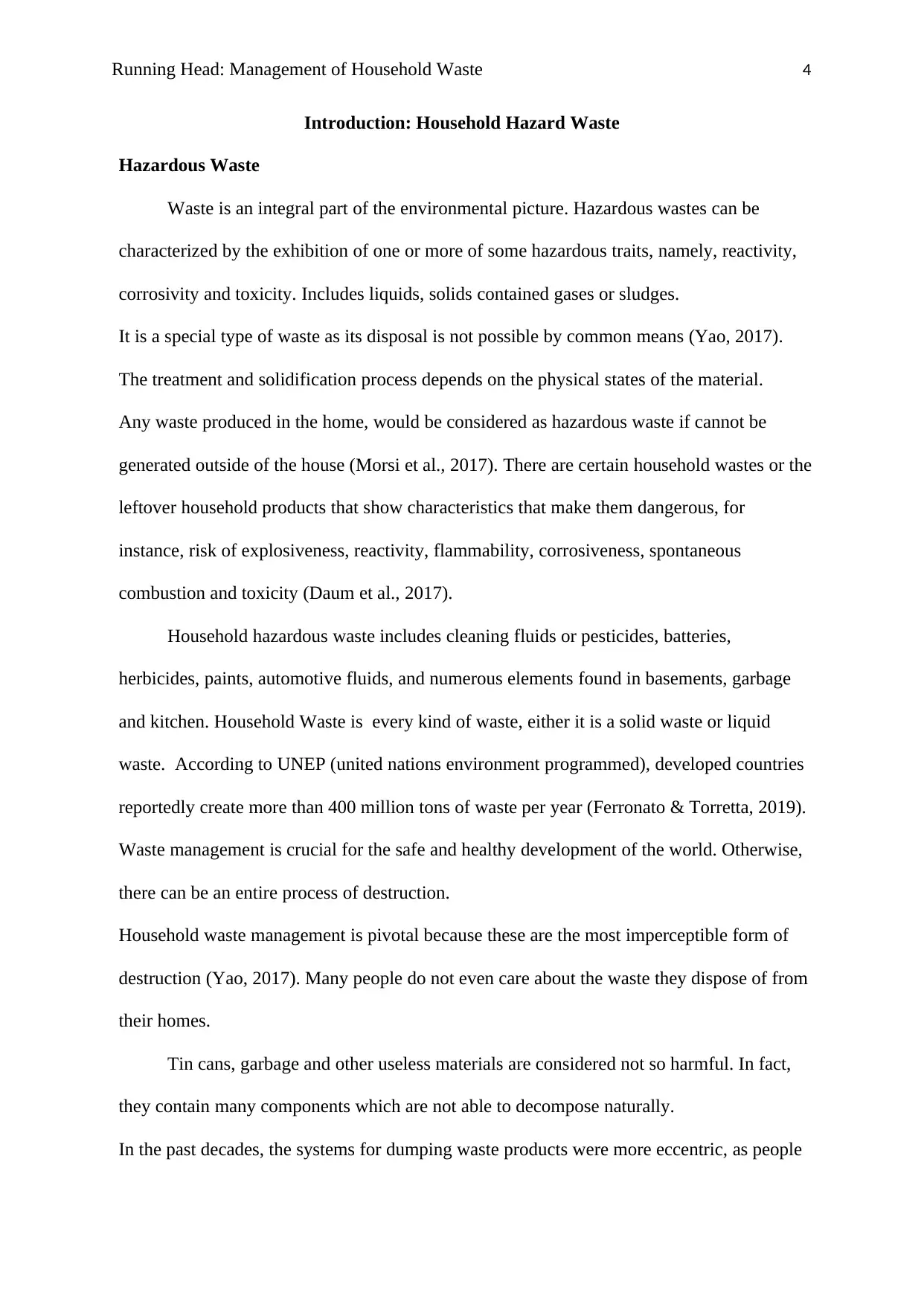
Running Head: Management of Household Waste 4
Introduction: Household Hazard Waste
Hazardous Waste
Waste is an integral part of the environmental picture. Hazardous wastes can be
characterized by the exhibition of one or more of some hazardous traits, namely, reactivity,
corrosivity and toxicity. Includes liquids, solids contained gases or sludges.
It is a special type of waste as its disposal is not possible by common means (Yao, 2017).
The treatment and solidification process depends on the physical states of the material.
Any waste produced in the home, would be considered as hazardous waste if cannot be
generated outside of the house (Morsi et al., 2017). There are certain household wastes or the
leftover household products that show characteristics that make them dangerous, for
instance, risk of explosiveness, reactivity, flammability, corrosiveness, spontaneous
combustion and toxicity (Daum et al., 2017).
Household hazardous waste includes cleaning fluids or pesticides, batteries,
herbicides, paints, automotive fluids, and numerous elements found in basements, garbage
and kitchen. Household Waste is every kind of waste, either it is a solid waste or liquid
waste. According to UNEP (united nations environment programmed), developed countries
reportedly create more than 400 million tons of waste per year (Ferronato & Torretta, 2019).
Waste management is crucial for the safe and healthy development of the world. Otherwise,
there can be an entire process of destruction.
Household waste management is pivotal because these are the most imperceptible form of
destruction (Yao, 2017). Many people do not even care about the waste they dispose of from
their homes.
Tin cans, garbage and other useless materials are considered not so harmful. In fact,
they contain many components which are not able to decompose naturally.
In the past decades, the systems for dumping waste products were more eccentric, as people
Introduction: Household Hazard Waste
Hazardous Waste
Waste is an integral part of the environmental picture. Hazardous wastes can be
characterized by the exhibition of one or more of some hazardous traits, namely, reactivity,
corrosivity and toxicity. Includes liquids, solids contained gases or sludges.
It is a special type of waste as its disposal is not possible by common means (Yao, 2017).
The treatment and solidification process depends on the physical states of the material.
Any waste produced in the home, would be considered as hazardous waste if cannot be
generated outside of the house (Morsi et al., 2017). There are certain household wastes or the
leftover household products that show characteristics that make them dangerous, for
instance, risk of explosiveness, reactivity, flammability, corrosiveness, spontaneous
combustion and toxicity (Daum et al., 2017).
Household hazardous waste includes cleaning fluids or pesticides, batteries,
herbicides, paints, automotive fluids, and numerous elements found in basements, garbage
and kitchen. Household Waste is every kind of waste, either it is a solid waste or liquid
waste. According to UNEP (united nations environment programmed), developed countries
reportedly create more than 400 million tons of waste per year (Ferronato & Torretta, 2019).
Waste management is crucial for the safe and healthy development of the world. Otherwise,
there can be an entire process of destruction.
Household waste management is pivotal because these are the most imperceptible form of
destruction (Yao, 2017). Many people do not even care about the waste they dispose of from
their homes.
Tin cans, garbage and other useless materials are considered not so harmful. In fact,
they contain many components which are not able to decompose naturally.
In the past decades, the systems for dumping waste products were more eccentric, as people
Paraphrase This Document
Need a fresh take? Get an instant paraphrase of this document with our AI Paraphraser
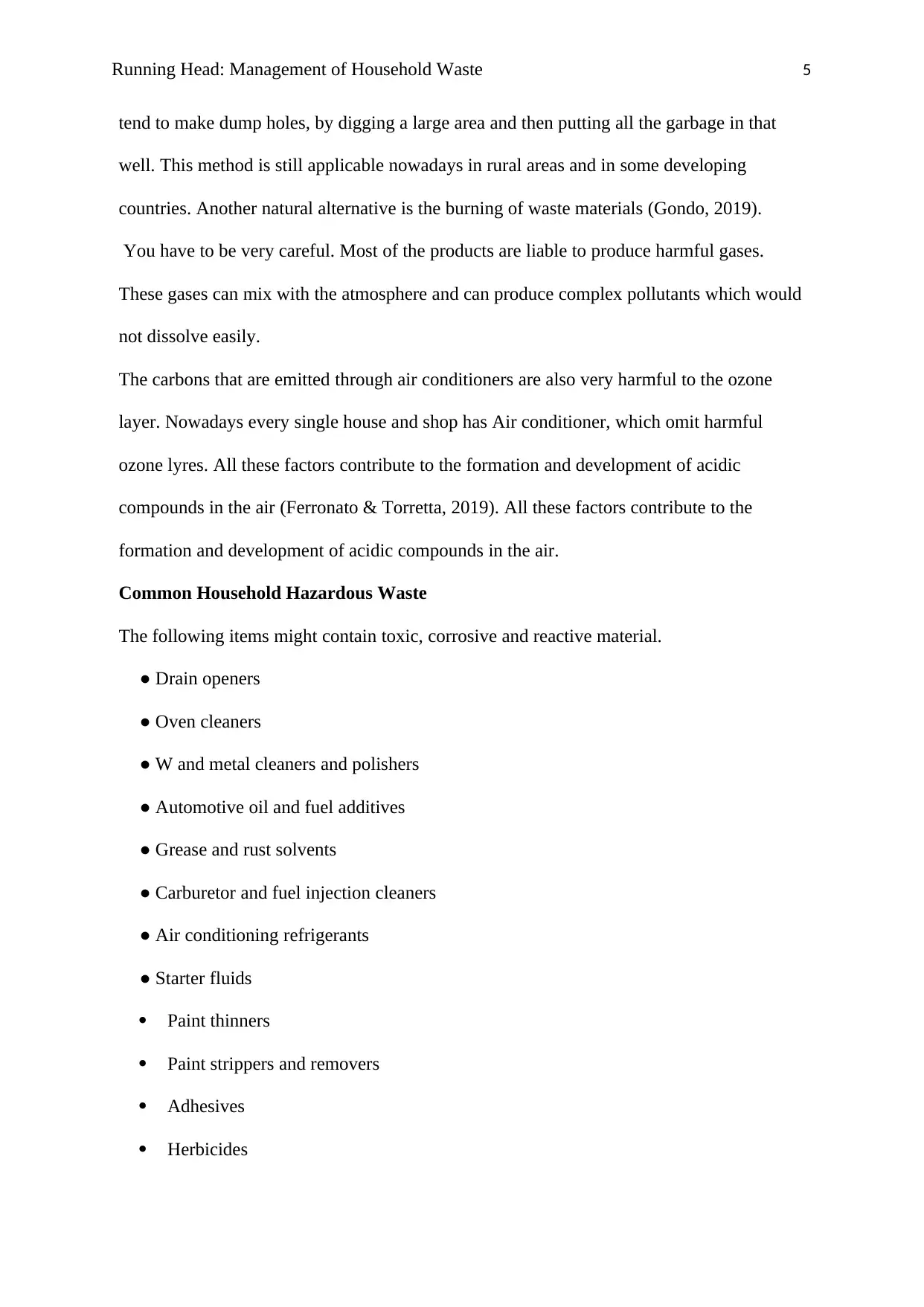
Running Head: Management of Household Waste 5
tend to make dump holes, by digging a large area and then putting all the garbage in that
well. This method is still applicable nowadays in rural areas and in some developing
countries. Another natural alternative is the burning of waste materials (Gondo, 2019).
You have to be very careful. Most of the products are liable to produce harmful gases.
These gases can mix with the atmosphere and can produce complex pollutants which would
not dissolve easily.
The carbons that are emitted through air conditioners are also very harmful to the ozone
layer. Nowadays every single house and shop has Air conditioner, which omit harmful
ozone lyres. All these factors contribute to the formation and development of acidic
compounds in the air (Ferronato & Torretta, 2019). All these factors contribute to the
formation and development of acidic compounds in the air.
Common Household Hazardous Waste
The following items might contain toxic, corrosive and reactive material.
● Drain openers
● Oven cleaners
● W and metal cleaners and polishers
● Automotive oil and fuel additives
● Grease and rust solvents
● Carburetor and fuel injection cleaners
● Air conditioning refrigerants
● Starter fluids
Paint thinners
Paint strippers and removers
Adhesives
Herbicides
tend to make dump holes, by digging a large area and then putting all the garbage in that
well. This method is still applicable nowadays in rural areas and in some developing
countries. Another natural alternative is the burning of waste materials (Gondo, 2019).
You have to be very careful. Most of the products are liable to produce harmful gases.
These gases can mix with the atmosphere and can produce complex pollutants which would
not dissolve easily.
The carbons that are emitted through air conditioners are also very harmful to the ozone
layer. Nowadays every single house and shop has Air conditioner, which omit harmful
ozone lyres. All these factors contribute to the formation and development of acidic
compounds in the air (Ferronato & Torretta, 2019). All these factors contribute to the
formation and development of acidic compounds in the air.
Common Household Hazardous Waste
The following items might contain toxic, corrosive and reactive material.
● Drain openers
● Oven cleaners
● W and metal cleaners and polishers
● Automotive oil and fuel additives
● Grease and rust solvents
● Carburetor and fuel injection cleaners
● Air conditioning refrigerants
● Starter fluids
Paint thinners
Paint strippers and removers
Adhesives
Herbicides
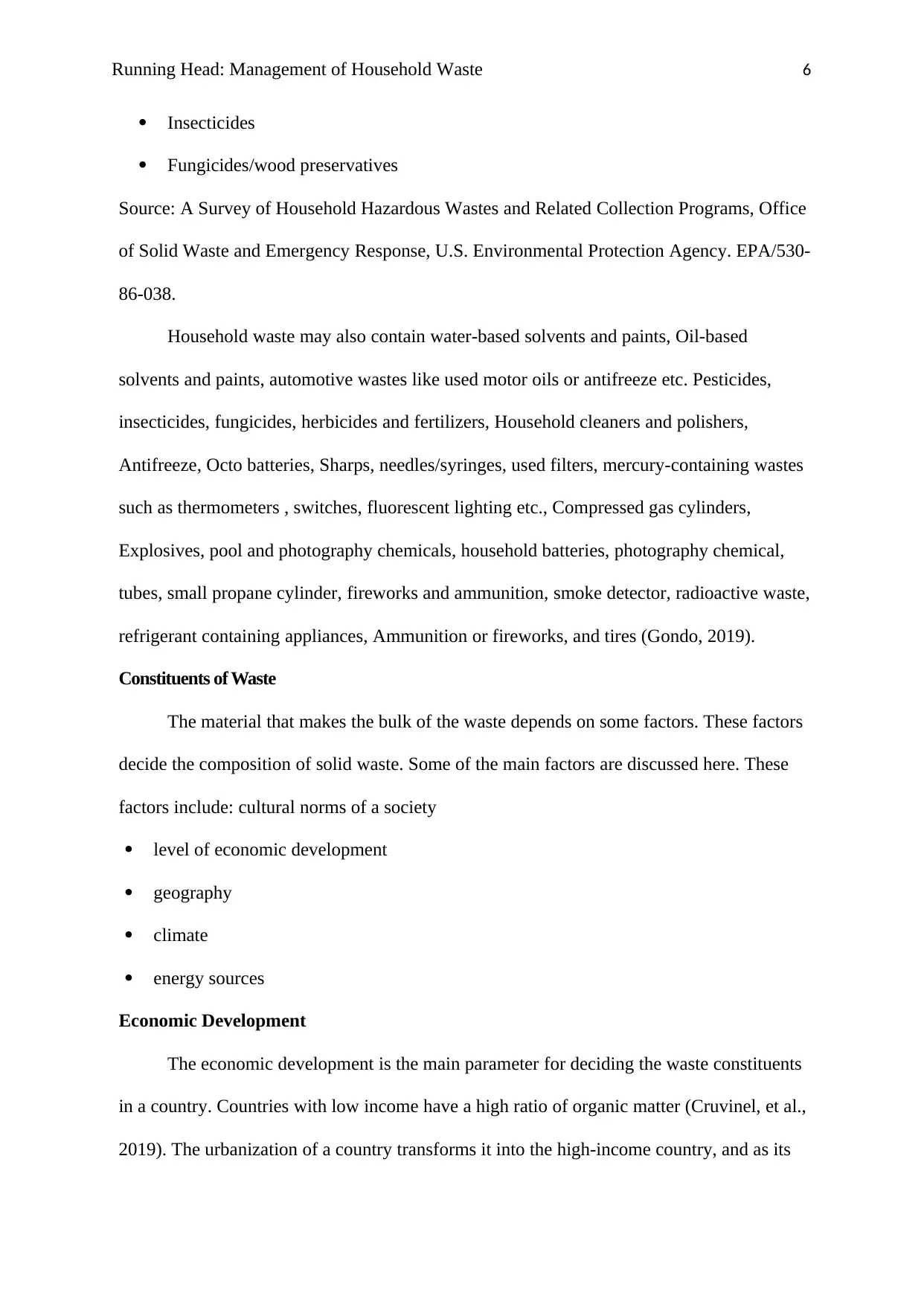
Running Head: Management of Household Waste 6
Insecticides
Fungicides/wood preservatives
Source: A Survey of Household Hazardous Wastes and Related Collection Programs, Office
of Solid Waste and Emergency Response, U.S. Environmental Protection Agency. EPA/530-
86-038.
Household waste may also contain water-based solvents and paints, Oil-based
solvents and paints, automotive wastes like used motor oils or antifreeze etc. Pesticides,
insecticides, fungicides, herbicides and fertilizers, Household cleaners and polishers,
Antifreeze, Octo batteries, Sharps, needles/syringes, used filters, mercury-containing wastes
such as thermometers , switches, fluorescent lighting etc., Compressed gas cylinders,
Explosives, pool and photography chemicals, household batteries, photography chemical,
tubes, small propane cylinder, fireworks and ammunition, smoke detector, radioactive waste,
refrigerant containing appliances, Ammunition or fireworks, and tires (Gondo, 2019).
Constituents of Waste
The material that makes the bulk of the waste depends on some factors. These factors
decide the composition of solid waste. Some of the main factors are discussed here. These
factors include: cultural norms of a society
level of economic development
geography
climate
energy sources
Economic Development
The economic development is the main parameter for deciding the waste constituents
in a country. Countries with low income have a high ratio of organic matter (Cruvinel, et al.,
2019). The urbanization of a country transforms it into the high-income country, and as its
Insecticides
Fungicides/wood preservatives
Source: A Survey of Household Hazardous Wastes and Related Collection Programs, Office
of Solid Waste and Emergency Response, U.S. Environmental Protection Agency. EPA/530-
86-038.
Household waste may also contain water-based solvents and paints, Oil-based
solvents and paints, automotive wastes like used motor oils or antifreeze etc. Pesticides,
insecticides, fungicides, herbicides and fertilizers, Household cleaners and polishers,
Antifreeze, Octo batteries, Sharps, needles/syringes, used filters, mercury-containing wastes
such as thermometers , switches, fluorescent lighting etc., Compressed gas cylinders,
Explosives, pool and photography chemicals, household batteries, photography chemical,
tubes, small propane cylinder, fireworks and ammunition, smoke detector, radioactive waste,
refrigerant containing appliances, Ammunition or fireworks, and tires (Gondo, 2019).
Constituents of Waste
The material that makes the bulk of the waste depends on some factors. These factors
decide the composition of solid waste. Some of the main factors are discussed here. These
factors include: cultural norms of a society
level of economic development
geography
climate
energy sources
Economic Development
The economic development is the main parameter for deciding the waste constituents
in a country. Countries with low income have a high ratio of organic matter (Cruvinel, et al.,
2019). The urbanization of a country transforms it into the high-income country, and as its
⊘ This is a preview!⊘
Do you want full access?
Subscribe today to unlock all pages.

Trusted by 1+ million students worldwide
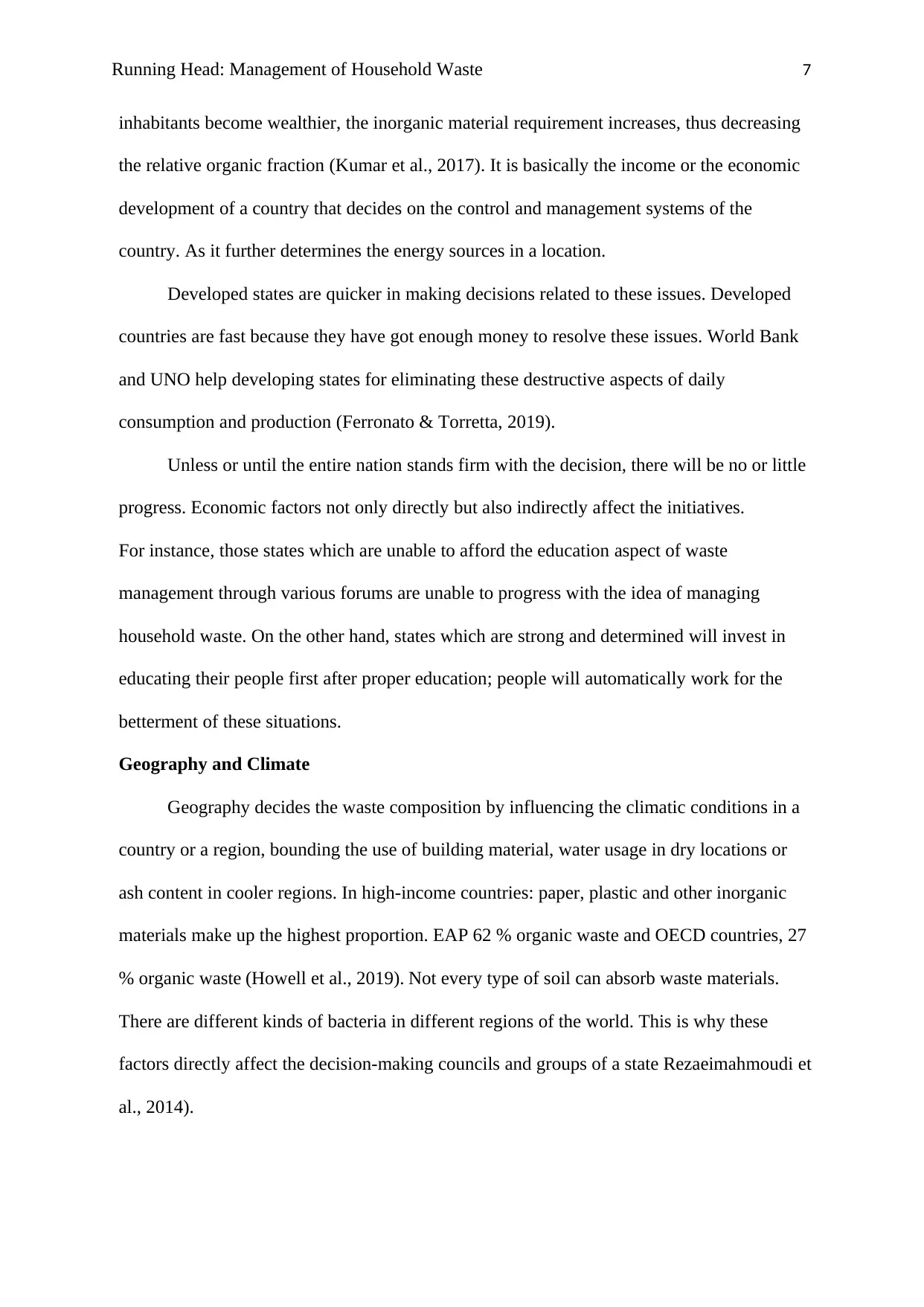
Running Head: Management of Household Waste 7
inhabitants become wealthier, the inorganic material requirement increases, thus decreasing
the relative organic fraction (Kumar et al., 2017). It is basically the income or the economic
development of a country that decides on the control and management systems of the
country. As it further determines the energy sources in a location.
Developed states are quicker in making decisions related to these issues. Developed
countries are fast because they have got enough money to resolve these issues. World Bank
and UNO help developing states for eliminating these destructive aspects of daily
consumption and production (Ferronato & Torretta, 2019).
Unless or until the entire nation stands firm with the decision, there will be no or little
progress. Economic factors not only directly but also indirectly affect the initiatives.
For instance, those states which are unable to afford the education aspect of waste
management through various forums are unable to progress with the idea of managing
household waste. On the other hand, states which are strong and determined will invest in
educating their people first after proper education; people will automatically work for the
betterment of these situations.
Geography and Climate
Geography decides the waste composition by influencing the climatic conditions in a
country or a region, bounding the use of building material, water usage in dry locations or
ash content in cooler regions. In high-income countries: paper, plastic and other inorganic
materials make up the highest proportion. EAP 62 % organic waste and OECD countries, 27
% organic waste (Howell et al., 2019). Not every type of soil can absorb waste materials.
There are different kinds of bacteria in different regions of the world. This is why these
factors directly affect the decision-making councils and groups of a state Rezaeimahmoudi et
al., 2014).
inhabitants become wealthier, the inorganic material requirement increases, thus decreasing
the relative organic fraction (Kumar et al., 2017). It is basically the income or the economic
development of a country that decides on the control and management systems of the
country. As it further determines the energy sources in a location.
Developed states are quicker in making decisions related to these issues. Developed
countries are fast because they have got enough money to resolve these issues. World Bank
and UNO help developing states for eliminating these destructive aspects of daily
consumption and production (Ferronato & Torretta, 2019).
Unless or until the entire nation stands firm with the decision, there will be no or little
progress. Economic factors not only directly but also indirectly affect the initiatives.
For instance, those states which are unable to afford the education aspect of waste
management through various forums are unable to progress with the idea of managing
household waste. On the other hand, states which are strong and determined will invest in
educating their people first after proper education; people will automatically work for the
betterment of these situations.
Geography and Climate
Geography decides the waste composition by influencing the climatic conditions in a
country or a region, bounding the use of building material, water usage in dry locations or
ash content in cooler regions. In high-income countries: paper, plastic and other inorganic
materials make up the highest proportion. EAP 62 % organic waste and OECD countries, 27
% organic waste (Howell et al., 2019). Not every type of soil can absorb waste materials.
There are different kinds of bacteria in different regions of the world. This is why these
factors directly affect the decision-making councils and groups of a state Rezaeimahmoudi et
al., 2014).
Paraphrase This Document
Need a fresh take? Get an instant paraphrase of this document with our AI Paraphraser
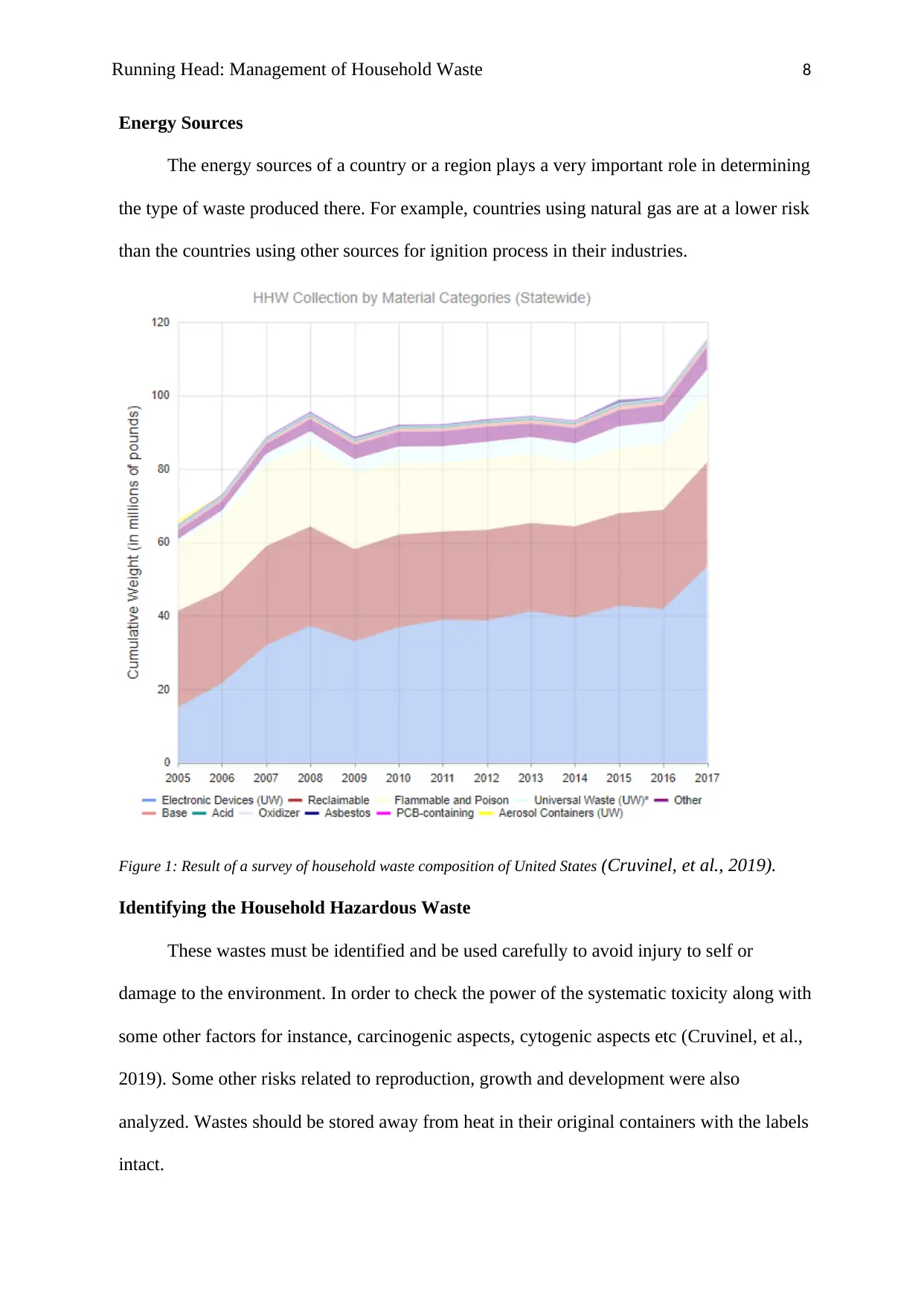
Running Head: Management of Household Waste 8
Energy Sources
The energy sources of a country or a region plays a very important role in determining
the type of waste produced there. For example, countries using natural gas are at a lower risk
than the countries using other sources for ignition process in their industries.
Figure 1: Result of a survey of household waste composition of United States (Cruvinel, et al., 2019).
Identifying the Household Hazardous Waste
These wastes must be identified and be used carefully to avoid injury to self or
damage to the environment. In order to check the power of the systematic toxicity along with
some other factors for instance, carcinogenic aspects, cytogenic aspects etc (Cruvinel, et al.,
2019). Some other risks related to reproduction, growth and development were also
analyzed. Wastes should be stored away from heat in their original containers with the labels
intact.
Energy Sources
The energy sources of a country or a region plays a very important role in determining
the type of waste produced there. For example, countries using natural gas are at a lower risk
than the countries using other sources for ignition process in their industries.
Figure 1: Result of a survey of household waste composition of United States (Cruvinel, et al., 2019).
Identifying the Household Hazardous Waste
These wastes must be identified and be used carefully to avoid injury to self or
damage to the environment. In order to check the power of the systematic toxicity along with
some other factors for instance, carcinogenic aspects, cytogenic aspects etc (Cruvinel, et al.,
2019). Some other risks related to reproduction, growth and development were also
analyzed. Wastes should be stored away from heat in their original containers with the labels
intact.
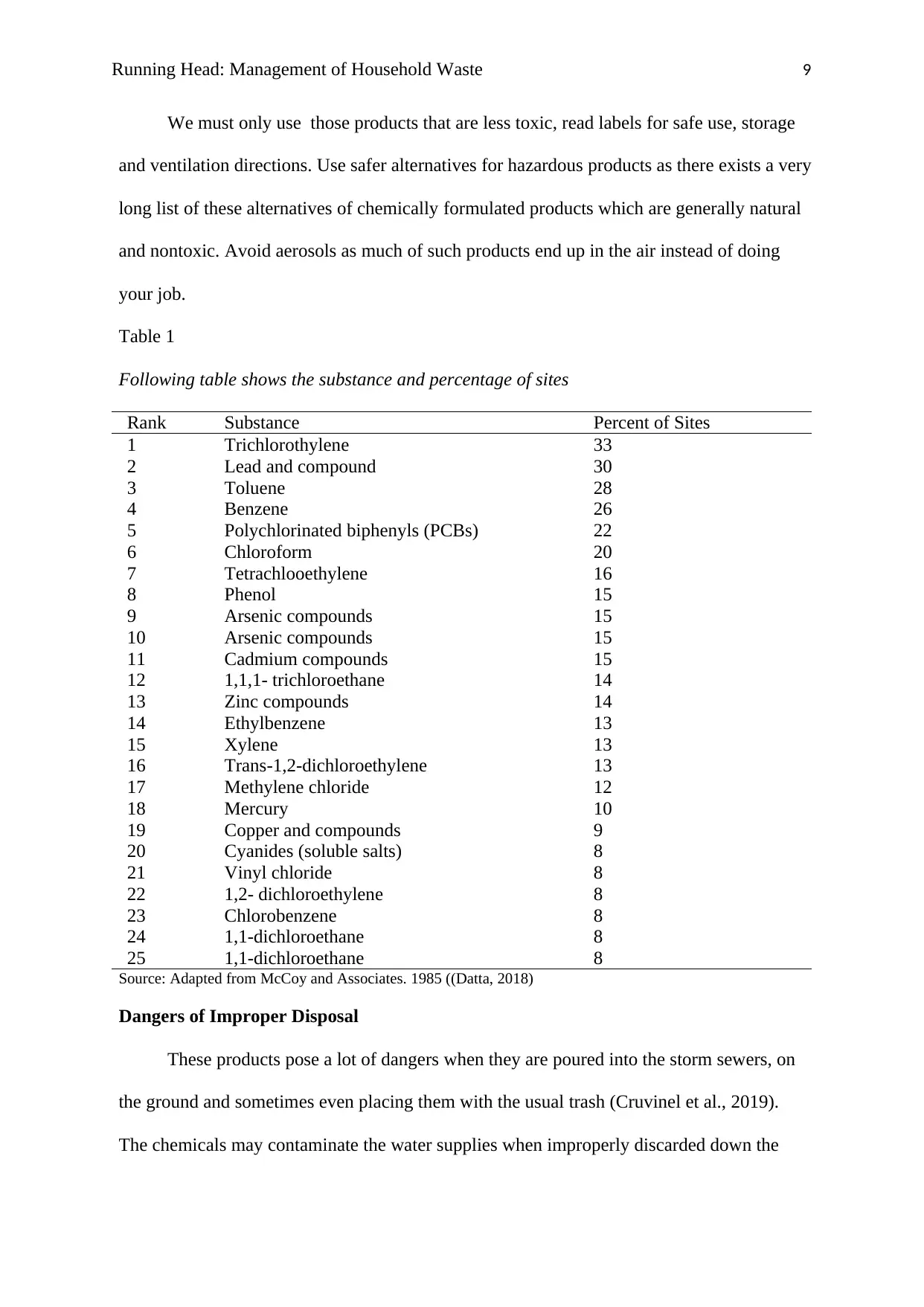
Running Head: Management of Household Waste 9
We must only use those products that are less toxic, read labels for safe use, storage
and ventilation directions. Use safer alternatives for hazardous products as there exists a very
long list of these alternatives of chemically formulated products which are generally natural
and nontoxic. Avoid aerosols as much of such products end up in the air instead of doing
your job.
Table 1
Following table shows the substance and percentage of sites
Rank Substance Percent of Sites
1 Trichlorothylene 33
2 Lead and compound 30
3 Toluene 28
4 Benzene 26
5 Polychlorinated biphenyls (PCBs) 22
6 Chloroform 20
7 Tetrachlooethylene 16
8 Phenol 15
9 Arsenic compounds 15
10 Arsenic compounds 15
11 Cadmium compounds 15
12 1,1,1- trichloroethane 14
13 Zinc compounds 14
14 Ethylbenzene 13
15 Xylene 13
16 Trans-1,2-dichloroethylene 13
17 Methylene chloride 12
18 Mercury 10
19 Copper and compounds 9
20 Cyanides (soluble salts) 8
21 Vinyl chloride 8
22 1,2- dichloroethylene 8
23 Chlorobenzene 8
24 1,1-dichloroethane 8
25 1,1-dichloroethane 8
Source: Adapted from McCoy and Associates. 1985 ((Datta, 2018)
Dangers of Improper Disposal
These products pose a lot of dangers when they are poured into the storm sewers, on
the ground and sometimes even placing them with the usual trash (Cruvinel et al., 2019).
The chemicals may contaminate the water supplies when improperly discarded down the
We must only use those products that are less toxic, read labels for safe use, storage
and ventilation directions. Use safer alternatives for hazardous products as there exists a very
long list of these alternatives of chemically formulated products which are generally natural
and nontoxic. Avoid aerosols as much of such products end up in the air instead of doing
your job.
Table 1
Following table shows the substance and percentage of sites
Rank Substance Percent of Sites
1 Trichlorothylene 33
2 Lead and compound 30
3 Toluene 28
4 Benzene 26
5 Polychlorinated biphenyls (PCBs) 22
6 Chloroform 20
7 Tetrachlooethylene 16
8 Phenol 15
9 Arsenic compounds 15
10 Arsenic compounds 15
11 Cadmium compounds 15
12 1,1,1- trichloroethane 14
13 Zinc compounds 14
14 Ethylbenzene 13
15 Xylene 13
16 Trans-1,2-dichloroethylene 13
17 Methylene chloride 12
18 Mercury 10
19 Copper and compounds 9
20 Cyanides (soluble salts) 8
21 Vinyl chloride 8
22 1,2- dichloroethylene 8
23 Chlorobenzene 8
24 1,1-dichloroethane 8
25 1,1-dichloroethane 8
Source: Adapted from McCoy and Associates. 1985 ((Datta, 2018)
Dangers of Improper Disposal
These products pose a lot of dangers when they are poured into the storm sewers, on
the ground and sometimes even placing them with the usual trash (Cruvinel et al., 2019).
The chemicals may contaminate the water supplies when improperly discarded down the
⊘ This is a preview!⊘
Do you want full access?
Subscribe today to unlock all pages.

Trusted by 1+ million students worldwide
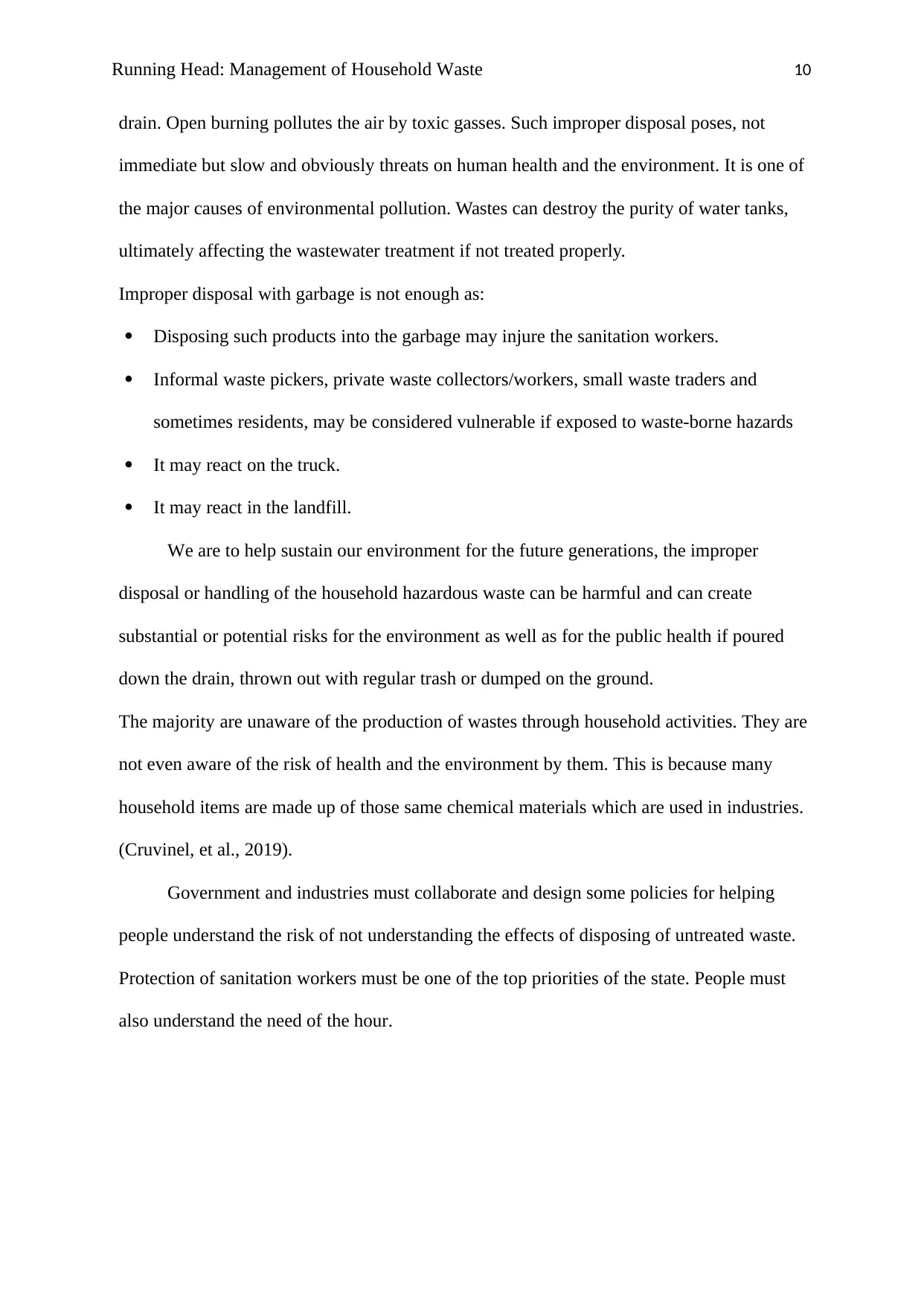
Running Head: Management of Household Waste 10
drain. Open burning pollutes the air by toxic gasses. Such improper disposal poses, not
immediate but slow and obviously threats on human health and the environment. It is one of
the major causes of environmental pollution. Wastes can destroy the purity of water tanks,
ultimately affecting the wastewater treatment if not treated properly.
Improper disposal with garbage is not enough as:
Disposing such products into the garbage may injure the sanitation workers.
Informal waste pickers, private waste collectors/workers, small waste traders and
sometimes residents, may be considered vulnerable if exposed to waste-borne hazards
It may react on the truck.
It may react in the landfill.
We are to help sustain our environment for the future generations, the improper
disposal or handling of the household hazardous waste can be harmful and can create
substantial or potential risks for the environment as well as for the public health if poured
down the drain, thrown out with regular trash or dumped on the ground.
The majority are unaware of the production of wastes through household activities. They are
not even aware of the risk of health and the environment by them. This is because many
household items are made up of those same chemical materials which are used in industries.
(Cruvinel, et al., 2019).
Government and industries must collaborate and design some policies for helping
people understand the risk of not understanding the effects of disposing of untreated waste.
Protection of sanitation workers must be one of the top priorities of the state. People must
also understand the need of the hour.
drain. Open burning pollutes the air by toxic gasses. Such improper disposal poses, not
immediate but slow and obviously threats on human health and the environment. It is one of
the major causes of environmental pollution. Wastes can destroy the purity of water tanks,
ultimately affecting the wastewater treatment if not treated properly.
Improper disposal with garbage is not enough as:
Disposing such products into the garbage may injure the sanitation workers.
Informal waste pickers, private waste collectors/workers, small waste traders and
sometimes residents, may be considered vulnerable if exposed to waste-borne hazards
It may react on the truck.
It may react in the landfill.
We are to help sustain our environment for the future generations, the improper
disposal or handling of the household hazardous waste can be harmful and can create
substantial or potential risks for the environment as well as for the public health if poured
down the drain, thrown out with regular trash or dumped on the ground.
The majority are unaware of the production of wastes through household activities. They are
not even aware of the risk of health and the environment by them. This is because many
household items are made up of those same chemical materials which are used in industries.
(Cruvinel, et al., 2019).
Government and industries must collaborate and design some policies for helping
people understand the risk of not understanding the effects of disposing of untreated waste.
Protection of sanitation workers must be one of the top priorities of the state. People must
also understand the need of the hour.
Paraphrase This Document
Need a fresh take? Get an instant paraphrase of this document with our AI Paraphraser
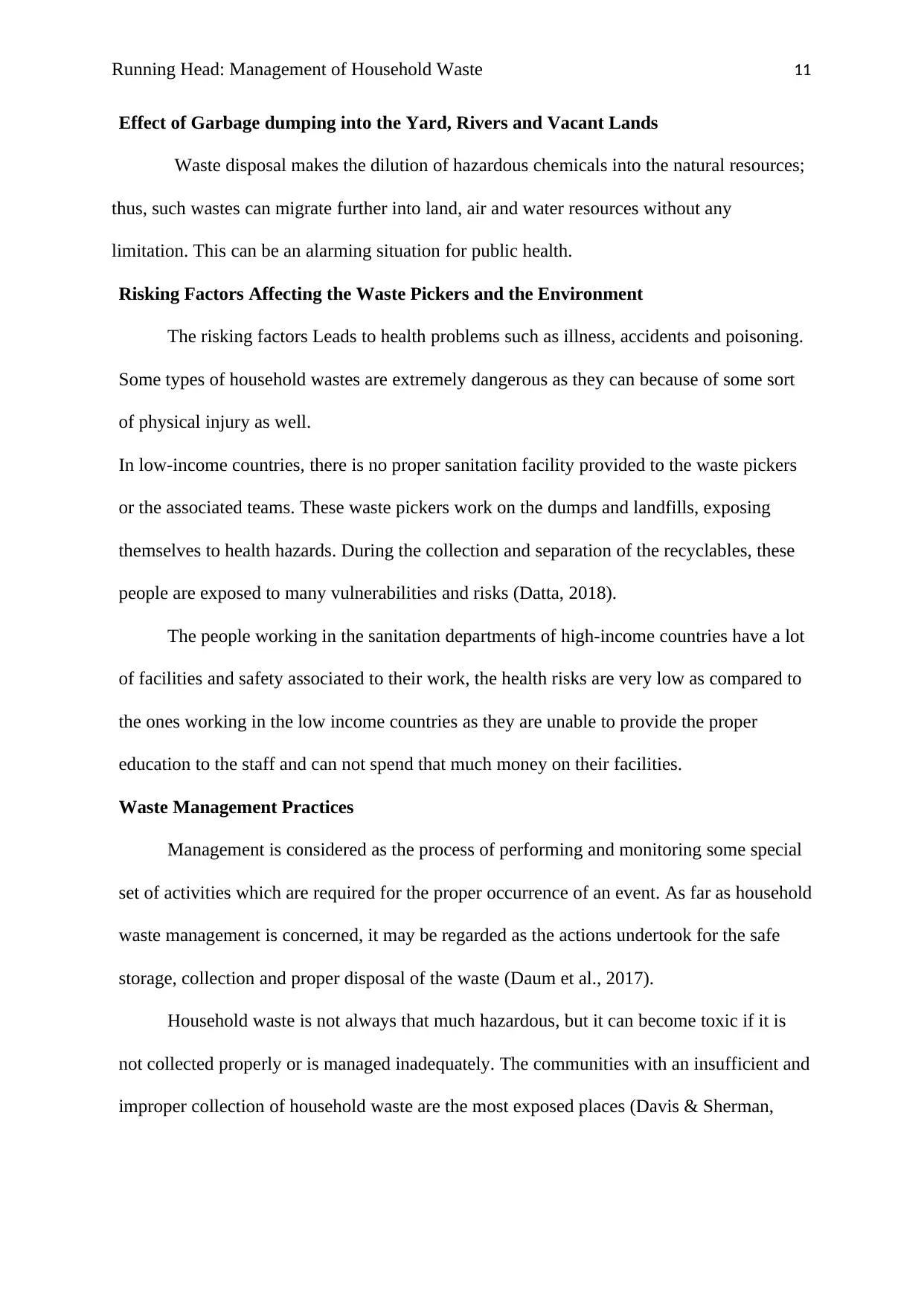
Running Head: Management of Household Waste 11
Effect of Garbage dumping into the Yard, Rivers and Vacant Lands
Waste disposal makes the dilution of hazardous chemicals into the natural resources;
thus, such wastes can migrate further into land, air and water resources without any
limitation. This can be an alarming situation for public health.
Risking Factors Affecting the Waste Pickers and the Environment
The risking factors Leads to health problems such as illness, accidents and poisoning.
Some types of household wastes are extremely dangerous as they can because of some sort
of physical injury as well.
In low-income countries, there is no proper sanitation facility provided to the waste pickers
or the associated teams. These waste pickers work on the dumps and landfills, exposing
themselves to health hazards. During the collection and separation of the recyclables, these
people are exposed to many vulnerabilities and risks (Datta, 2018).
The people working in the sanitation departments of high-income countries have a lot
of facilities and safety associated to their work, the health risks are very low as compared to
the ones working in the low income countries as they are unable to provide the proper
education to the staff and can not spend that much money on their facilities.
Waste Management Practices
Management is considered as the process of performing and monitoring some special
set of activities which are required for the proper occurrence of an event. As far as household
waste management is concerned, it may be regarded as the actions undertook for the safe
storage, collection and proper disposal of the waste (Daum et al., 2017).
Household waste is not always that much hazardous, but it can become toxic if it is
not collected properly or is managed inadequately. The communities with an insufficient and
improper collection of household waste are the most exposed places (Davis & Sherman,
Effect of Garbage dumping into the Yard, Rivers and Vacant Lands
Waste disposal makes the dilution of hazardous chemicals into the natural resources;
thus, such wastes can migrate further into land, air and water resources without any
limitation. This can be an alarming situation for public health.
Risking Factors Affecting the Waste Pickers and the Environment
The risking factors Leads to health problems such as illness, accidents and poisoning.
Some types of household wastes are extremely dangerous as they can because of some sort
of physical injury as well.
In low-income countries, there is no proper sanitation facility provided to the waste pickers
or the associated teams. These waste pickers work on the dumps and landfills, exposing
themselves to health hazards. During the collection and separation of the recyclables, these
people are exposed to many vulnerabilities and risks (Datta, 2018).
The people working in the sanitation departments of high-income countries have a lot
of facilities and safety associated to their work, the health risks are very low as compared to
the ones working in the low income countries as they are unable to provide the proper
education to the staff and can not spend that much money on their facilities.
Waste Management Practices
Management is considered as the process of performing and monitoring some special
set of activities which are required for the proper occurrence of an event. As far as household
waste management is concerned, it may be regarded as the actions undertook for the safe
storage, collection and proper disposal of the waste (Daum et al., 2017).
Household waste is not always that much hazardous, but it can become toxic if it is
not collected properly or is managed inadequately. The communities with an insufficient and
improper collection of household waste are the most exposed places (Davis & Sherman,
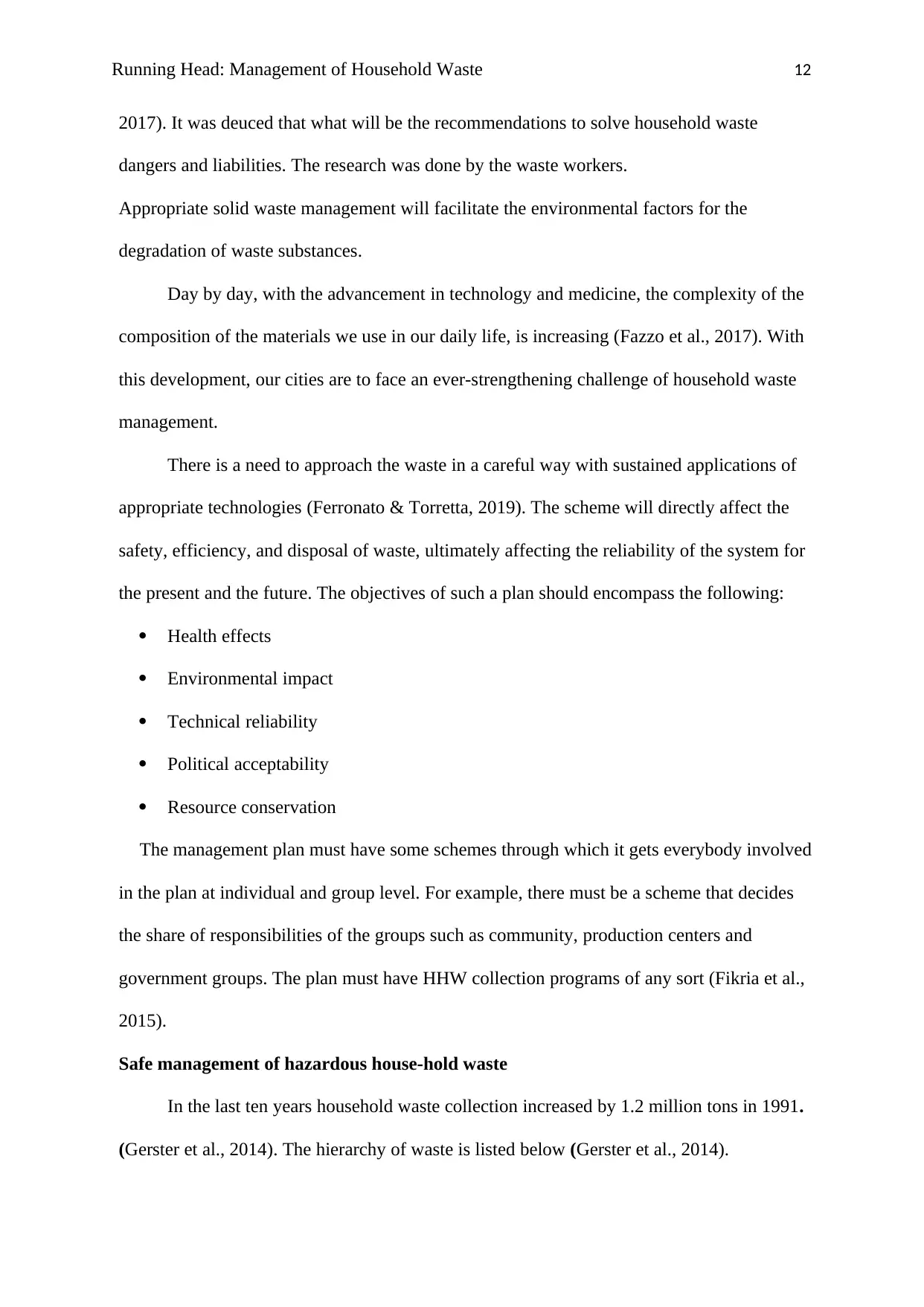
Running Head: Management of Household Waste 12
2017). It was deuced that what will be the recommendations to solve household waste
dangers and liabilities. The research was done by the waste workers.
Appropriate solid waste management will facilitate the environmental factors for the
degradation of waste substances.
Day by day, with the advancement in technology and medicine, the complexity of the
composition of the materials we use in our daily life, is increasing (Fazzo et al., 2017). With
this development, our cities are to face an ever-strengthening challenge of household waste
management.
There is a need to approach the waste in a careful way with sustained applications of
appropriate technologies (Ferronato & Torretta, 2019). The scheme will directly affect the
safety, efficiency, and disposal of waste, ultimately affecting the reliability of the system for
the present and the future. The objectives of such a plan should encompass the following:
Health effects
Environmental impact
Technical reliability
Political acceptability
Resource conservation
The management plan must have some schemes through which it gets everybody involved
in the plan at individual and group level. For example, there must be a scheme that decides
the share of responsibilities of the groups such as community, production centers and
government groups. The plan must have HHW collection programs of any sort (Fikria et al.,
2015).
Safe management of hazardous house-hold waste
In the last ten years household waste collection increased by 1.2 million tons in 1991.
(Gerster et al., 2014). The hierarchy of waste is listed below (Gerster et al., 2014).
2017). It was deuced that what will be the recommendations to solve household waste
dangers and liabilities. The research was done by the waste workers.
Appropriate solid waste management will facilitate the environmental factors for the
degradation of waste substances.
Day by day, with the advancement in technology and medicine, the complexity of the
composition of the materials we use in our daily life, is increasing (Fazzo et al., 2017). With
this development, our cities are to face an ever-strengthening challenge of household waste
management.
There is a need to approach the waste in a careful way with sustained applications of
appropriate technologies (Ferronato & Torretta, 2019). The scheme will directly affect the
safety, efficiency, and disposal of waste, ultimately affecting the reliability of the system for
the present and the future. The objectives of such a plan should encompass the following:
Health effects
Environmental impact
Technical reliability
Political acceptability
Resource conservation
The management plan must have some schemes through which it gets everybody involved
in the plan at individual and group level. For example, there must be a scheme that decides
the share of responsibilities of the groups such as community, production centers and
government groups. The plan must have HHW collection programs of any sort (Fikria et al.,
2015).
Safe management of hazardous house-hold waste
In the last ten years household waste collection increased by 1.2 million tons in 1991.
(Gerster et al., 2014). The hierarchy of waste is listed below (Gerster et al., 2014).
⊘ This is a preview!⊘
Do you want full access?
Subscribe today to unlock all pages.

Trusted by 1+ million students worldwide
1 out of 27
Related Documents
Your All-in-One AI-Powered Toolkit for Academic Success.
+13062052269
info@desklib.com
Available 24*7 on WhatsApp / Email
![[object Object]](/_next/static/media/star-bottom.7253800d.svg)
Unlock your academic potential
Copyright © 2020–2025 A2Z Services. All Rights Reserved. Developed and managed by ZUCOL.


